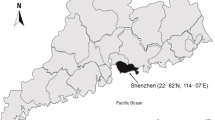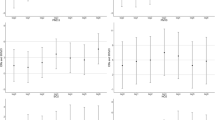Abstract
Objectives
This study aimed to determine the effect of ambient air pollution and temperature on stillbirth in Tehran.
Methods
In this time-series study, the effect of O3 (ppb), CO (ppm), NO2 (ppb), SO2 (ppb), PM2.5 (μg/m3), and minimum, maximum, and mean daily temperature (°C) on stillbirth was evaluated in Tehran, Iran between March 2015 and March 2018. Using a quasi-Poisson regression model in combination with a Distributed Lag Non-linear Models (DLNM), the Relative Risk (RR) was estimated through comparing the high temperature (99th, 95th, and 75th percentiles) and low temperature (1st, 5th, and 25th percentiles) with the median. The effect of air pollution was estimated for each 1-, 5-, or 10-unit increase in the concentration during lags (days) 0–21.
Results
Among air pollutants, only a 5-ppm increase in the SO2 concentration in lag 0 increased the risk of stillbirth significantly (RR = 1.062; 1.002–1.125). The largest effect of heat was observed while comparing the 99th percentile of minimum daily temperature (26.9 °C) with the median temperature (13.2 °C), which was not statistically significant (RR = 1.25; 0.95–1.65). As for cold, a non-significant protective effect was observed while comparing the 1st percentile of maximum daily temperature (3.1 °C) with the median temperature (23.2 °C) (RR = 0.92; 0.72–1.19).
Conclusion
Each 5-ppm increase in the mean daily SO2 in lag 0 increased the risk of stillbirth by 6% while other air pollutants had no significant effects on stillbirth. In lags 0 and 1, the heat increased the risk of stillbirth while the cold had protective effects, which were not statistically significant.




Similar content being viewed by others
References
Sexual and reproductive health; The neglected tragedy of stillbirths. World Heath Organization. 2017. http://www.who.int/reproductivehealth/topics/maternal_perinatal/stillbirth/en/.
Lawn JE, Blencowe H, Pattinson R, Cousens S, Kumar R, Ibiebele I, et al. Stillbirths: where? When? Why? How to make the data count? Lancet. 2011;377(9775):1448–63. https://doi.org/10.1016/s0140-6736(10)62187-3.
Hajian-Tilaki K, Esmaielzadeh S, Sadeghian G. Trend of stillbirth rates and the associated risk factors in Babol, northern Iran. Oman medical journal. 2014;29(1):18–23.
Jahani MA, Akbarian Rad Z, Naghavian M, Salmanian T, Haghshenas MM. Factors affecting stillbirth rate in the hospitals affiliated to Babol University of Medical Sciences. Iranian Journal of Neonatology IJN. 2015;6(3):22–7.
Nankali A, Hematti M, Mahdavi Z. Study of the factors associated with stillbirth in pregnant women admitted in Imam Reza Teaching Hospital in Kermanshah (2011–2014). The Iranian Journal of Obstetrics, Gynecology and Infertility. 2017;20(1):1–9. https://doi.org/10.22038/ijogi.2017.8617.
Liu L-C, Wang Y-C, Yu M-H, Su H-Y. Major risk factors for stillbirth in different trimesters of pregnancy—A systematic review. Taiwanese Journal of Obstetrics and Gynecology. 2014;53(2):141–5. https://doi.org/10.1016/j.tjog.2014.04.003.
Zhang Y, Yu C, Wang L. Temperature exposure during pregnancy and birth outcomes: an updated systematic review of epidemiological evidence. Environ Pollut. 2017;225:700–12.
Zhu X, Liu Y, Chen Y, Yao C, Che Z, Cao J. Maternal exposure to fine particulate matter (PM 2.5) and pregnancy outcomes: a meta-analysis. Environ Sci Pollut Res. 2015;22(5):3383–96.
Siddika N, Balogun HA, Amegah AK, Jaakkola JJ. Prenatal ambient air pollution exposure and the risk of stillbirth: systematic review and meta-analysis of the empirical evidence. Occup Environ Med. 2016;73(9):573–81.
Bonzini M, Carugno M, Grillo P, Mensi C, Bertazzi P, Pesatori AC. Impact of ambient air pollution on birth outcomes: systematic review of the current evidences. La Medicina del lavoro. 2010;101(5):341–63.
Sapkota A, Chelikowsky AP, Nachman KE, Cohen AJ, Ritz B. Exposure to particulate matter and adverse birth outcomes: a comprehensive review and meta-analysis. Air Quality, Atmosphere & Health. 2012;5(4):369–81.
World Health Organization. Ambient air pollution: Health impacts. 2019. https://www.who.int/airpollution/ambient/health-impacts/en/. Accessed 2019.
Shah PS, Balkhair T. Births KSGoDoPL. Air pollution and birth outcomes: a systematic review. Environ Int. 2011;37(2):498–516.
Pedersen M. Is it still important to study if ambient air pollution triggers stillbirth? Occup Environ Med. 2016;73(9):571–2.
Hajizadeh Y, Jafari N, Mohammadi A, Momtaz SM, Fanaei F, Abdolahnejad A. (2020) Concentrations and mortality due to short- and long-term exposure to PM(2.5) in a megacity of Iran (2014–2019). Environmental science and pollution research international. doi:https://doi.org/10.1007/s11356-020-09695-z.
Jaafari J, Naddafi K, Yunesian M, Nabizadeh R, Hassanvand MS, Ghozikali MG et al. Study of PM10, PM2. 5, and PM1 levels in during dust storms and local air pollution events in urban and rural sites in Tehran. 2018;24(2):482–93.
Jaafari J, Naddafi K, Yunesian M, Nabizadeh R, Hassanvand MS, Shamsipour M et al. (2020) The acute effects of short term exposure to particulate matter from natural and anthropogenic sources on inflammation and coagulation markers in healthy young adults 139417.
Jaafari J, Naddafi K, Yunesian M, Nabizadeh R, Hassanvand MS, Ghozikali MG et al. (2020) Characterization, risk assessment and potential source identification of PM10 in Tehran. 154:104533.
Dastoorpoor M, Idani E, Goudarzi G, Khanjani N. Acute effects of air pollution on spontaneous abortion, premature delivery, and stillbirth in Ahvaz, Iran: a time-series study. Environ Sci Pollut Res 2017:1–12.
Gasparrini A, Armstrong B, Kenward MG. Distributed lag non-linear models. Stat Med. 2010;29(21):2224–34.
Meteorological Data Request System. I.R. of Iran Meteorological Organization, Tehran, Iran. 2019. http://www.irimo.ir/far/index.php.
National Climatic Data Center, Global Summary of the Day (GSOD). National Oceanic and Atmospheric Administration, , U.S. Department of Commerce. https://www7.ncdc.noaa.gov/CDO/cdoselect.cmd?datasetabbv=GSOD. Accessed 2019 2019.
Goldman-Mellor S, Olfson M, Lidon-Moyano C, Schoenbaum M. Association of Suicide and Other Mortality with Emergency Department Presentation. JAMA Netw Open. 2019;2(12):e1917571. https://doi.org/10.1001/jamanetworkopen.2019.17571.
Tehran Annual Air Quality Report. period of March 2017- March 2018, QM97/02/01(U)/1″. 2018. http://air.tehran.ir/. 1.
Breuer D, Bower J. Monitoring ambient air quality for health impact assessment. WHO Regional Office Europe; 1999.
United States Environmental Protection Agency. NAAQS Table. US EPA. 2019. https://www.epa.gov/criteria-air-pollutants/naaqs-table.
Gasparrini A. Distributed lag linear and non-linear models in R: the package dlnm. J Stat Softw. 2011;43(8):1–20.
Muggeo VM. Analyzing temperature effects on mortality within the R environment: the constrained segmented distributed lag parameterization. J Stat Softw. 2010;32(12):1–17.
Strand LB, Barnett AG, Tong S. Maternal exposure to ambient temperature and the risks of preterm birth and stillbirth in Brisbane, Australia. Am J Epidemiol. 2011;175(2):99–107.
Arroyo V, Díaz J, Carmona R, Ortiz C, Linares C. Impact of air pollution and temperature on adverse birth outcomes: Madrid, 2001–2009. Environ Pollut. 2016;218:1154–61.
Auger N, Fraser WD, Smargiassi A, Bilodeau-Bertrand M, Kosatsky T. Elevated outdoor temperatures and risk of stillbirth. Int J Epidemiol. 2017;46(1):200–8.
Basu R, Sarovar V, Malig BJ. Association between high ambient temperature and risk of stillbirth in California. Am J Epidemiol. 2016;183(10):894–901.
Bruckner TA, Modin B, Vågerö D. Cold ambient temperature in utero and birth outcomes in Uppsala, Sweden, 1915–1929. Ann Epidemiol. 2014;24(2):116–21.
Li S, Chen G, Jaakkola JJ, Williams G, Guo Y. Temporal change in the impacts of ambient temperature on preterm birth and stillbirth: Brisbane, 1994–2013. Sci Total Environ. 2018;634:579–85.
Ha S, Liu D, Zhu Y, Soo Kim S, Sherman S, Grantz KL, et al. Ambient temperature and stillbirth: a multi-center retrospective cohort study. Environ Health Perspect. 2017;125(6):067011.
Vähä-Eskeli K, Erkkola R. The effect of short-term heat stress on uterine contractility, fetal heart rate and fetal movements at late pregnancy. European Journal of Obstetrics & Gynecology and Reproductive Biology. 1991;38(1):9–14.
Liang Z, Lin Y, Ma Y, Zhang L, Zhang X, Li L, et al. The association between ambient temperature and preterm birth in Shenzhen, China: a distributed lag non-linear time series analysis. Environ Health. 2016;15(1):84.
Stan C, Boulvain M, Hirsbrunner-Amagbaly P, Pfister R. Hydration for treatment of preterm labour. The Cochrane database of systematic reviews. 2002(2):Cd003096. doi:https://doi.org/10.1002/14651858.cd003096.
Basu R, Malig B, Ostro B. High ambient temperature and the risk of preterm delivery. Am J Epidemiol. 2010;172(10):1108–17. https://doi.org/10.1093/aje/kwq170.
Yackerson N, Piura B, Sheiner E. The influence of meteorological factors on the emergence of preterm delivery and preterm premature rupture of membrane. J Perinatol. 2008;28(10):707–11.
Li D-K, Janevic T, Odouli R, Liu L. Hot tub use during pregnancy and the risk of miscarriage. Am J Epidemiol. 2003;158(10):931–7.
Faiz AS, Rhoads GG, Demissie K, Lin Y, Kruse L, Rich DQ. Does ambient air pollution trigger stillbirth? Epidemiology. 2013;24:538–44.
Pereira LA, Loomis D, Conceicao GM, Braga AL, Arcas RM, Kishi HS, et al. Association between air pollution and intrauterine mortality in Sao Paulo. Brazil Environ Health Perspect. 1998;106(6):325–9. https://doi.org/10.1289/ehp.98106325.
Rammah A, Whitworth KW, Han I, Chan W, Symanski E. Time-varying exposure to ozone and risk of stillbirth in a nonattainment urban region. Am J Epidemiol. 2019;188(7):1288–95. https://doi.org/10.1093/aje/kwz095.
Zang H, Cheng H, Song W, Yang M, Han P, Chen C, et al. Ambient air pollution and the risk of stillbirth: a population-based prospective birth cohort study in the coastal area of China. Environ Sci Pollut Res Int. 2019;26(7):6717–24. https://doi.org/10.1007/s11356-019-04157-7.
Mendola P, Ha S, Pollack AZ, Zhu Y, Seeni I, Kim SS, et al. Chronic and acute ozone exposure in the week prior to delivery is associated with the risk of stillbirth. Int J Environ Res Public Health. 2017;14(7):731. https://doi.org/10.3390/ijerph14070731.
Singh J. Neonatal development altered by maternal sulfur dioxide exposure. Neurotoxicology. 1989;10(3):523–7.
Acknowledgments
The authors wish to thank the personnel of the Neonatasl Health Office, Iranian Ministry of Health and Medical Education, for their assistance in collecting the primary data.
Funding
This study was the result of a PhD thesis and was financially supported by Tehran University of Medical Sciences.
Author information
Authors and Affiliations
Corresponding author
Ethics declarations
Conflict of interests
Authors have no conflict of interests.
Additional information
Publisher’s note
Springer Nature remains neutral with regard to jurisdictional claims in published maps and institutional affiliations.
Rights and permissions
About this article
Cite this article
Ranjbaran, M., Mohammadi, R., Yaseri, M. et al. Effect of ambient air pollution and temperature on the risk of stillbirth: a distributed lag nonlinear time series analysis. J Environ Health Sci Engineer 18, 1289–1299 (2020). https://doi.org/10.1007/s40201-020-00547-z
Received:
Accepted:
Published:
Issue Date:
DOI: https://doi.org/10.1007/s40201-020-00547-z




